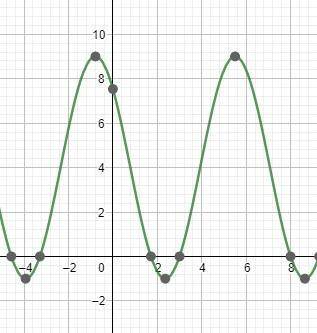



_____________________________

 2
2  64
64 26.8 in
Step-by-step explanation:
The red dashed line is the hypotenuse of the right triangle with one leg equal to 24 inches and the other leg equal to 12 inches. Its length is given by the Pythagorean theorem:
space diagonal = √(24^2 +12^2) = √(720) = 12√5
space diagonal ≈ 26.83 . . . inches
The length of the longest item that will fit in the box is about 26.83 inches.




_____________________________

 2
2  45
45 C)The comparison using median and IQR is best because one of the graphs is not symmetrical.
Step-by-step explanation:
I just took the test
 4
4 
Step-by-step explanation:
y = A cos (Bx - C) + D
A (amplitude) = max - DB = Period/2π ---> Period is the distance from max to next maxC = B · Phase Shift ---> Phase shift is distance from y-axis to maxD (vertical shift) = (max + min)/2D = (max + min)/2 = (3 - 11)/3 = -4
A = max - D = 3 - (-4) = 7
Period = 9π/4 - π/4 = 8π/4 = 2π
B = Period/2π = 2π/2π = 1
Phase Shift = π/4 - 0 = π/4
C = B · Phase Shift = 1 · π/4 = π/4
Equation:
y = 7 cos (1·x - π/4) + (-4)
 11
11 A = 2.5
Step-by-step explanation:
The highest point is 5.5. The lowest point is 0.5.




 3
3 The corrected program is:
import java.util.Scanner;
public class LabProgram{
public static void main(String[] args) {
Scanner scnr = new Scanner(System.in);
int qtr, dime, nickel, penny;
double dollars;
System.out.print("Quarters: ");
qtr =scnr.nextInt();
System.out.print("Dimes: ");
dime = scnr.nextInt();
System.out.print("Nickel: ");
nickel = scnr.nextInt();
System.out.print("Penny: ");
penny = scnr.nextInt();
dollars = qtr * 0.25 + dime * 0.1 + nickel * 0.05 + penny * 0.01;
System.out.printf("Amount: $%.2f\n", dollars);
System.out.print((dollars * 100)+" cents");
}
}
Explanation:
I've added the full program as an attachment where I used comments as explanation
 3
3 The answer to your question is 5(cosx + π/4) + 4
Step-by-step explanation:
General equation of trigonometric functions
f(x) = A(cos bx + c) + d
A = amplitude
b = period
c = change of phase
d = vertical change
Process
1.- Calculate amplitude
From the lowest to the highest point the function measures 10 units, but A is 10/2 then A = 5.
2.- Calculate period, the cosine graph goes from 0 to 2π. Period does not change so b = 1.
3.- Change of phase, the graph must start in (0, 1) but this graphs starts in (-π/4, 9) so c = π/4.
4.- Calculate the vertical displacement , it moved upward 4 units, so d = +4
5.- The equation is 5(cosx + π/4) + 4
6.- See my graph below


It will provide an instant answer!
